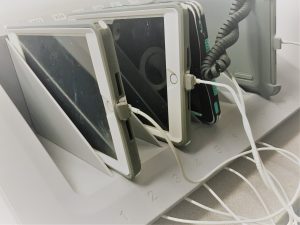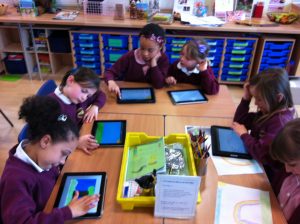
Google image from edutopia.org
“Teachers are challenging students to take ownership of their learning by using various online instructional tools. Teachers are using response systems, wikis, group online tasks, and peer assessment (Revere & Kovach, 2011). Teachers and students are using these online instructional tools as resources to instruct and learn, replacing the books and hard copy resources that have been used for decades.” (Cernansky, 5 & 6) In today’s learning environment a change in a digital approach has come about and teachers are viewing the implementation of technology as more than an added resource, but a primary one.
From the emergent levels of early childhood to tertiary and higher-education, the limit to use of technology and the advantages thereof are no secret. Just at one’s fingertips, the whole world and all its teachings and leaning opportunities alike are withheld. Students are eagerly intrigued and find digital interaction to be meaningful, looking for any way, shape or form to be engaged with technology. As educators, it is important to adapt to the mental model that technology is a primary resource and necessary learning tool.
“Some teachers have the mental model that online instructional tools are not necessary for quality instruction. Other teachers have the mental model that online instructional tools are necessary for quality instruction.” (Cernansky, 2) It is a common preconception that technology, due to its ‘viral and immediate access’ serves as a distraction in the learning environment. When this is the general mental model by the majority, the immense benefits are lost within the negative views. The implementation of technology in the classroom culture requires guided instruction as a foundational approach so that students are coached into using the equipment and the access thereof with digital responsibility and appropriateness.
In closely observing the mental models teachers hold when technology implementation is paired with online instructional tools also assists in giving school administrators to guide educators in developing various mental models beneficial to classroom plans.“The concept that teachers prepare and instruct differently because of the use of online instructional tools also drove this research. Teachers use technology to enhance their existing teacher-centered approach to instruction (Palak & Walls, 2009).”
Teachers of the recent study used as a reference for this post say “Teachers reported that they used online instructional tools to motivate their students with relevant and contemporary lessons.” (Cernansky, 7) It is imperative to meet students where they are most proficient. In this digital age, it is now time for educators to adapt to the tech-times and recognize that there are ways to utilize technology in the classroom in numerous creative ways which account for the diverse learners of the classroom. The seamless marriage of technology and learning softwares, websites and apps serves as a modern approach to old concepts. It begins with a change of perspective and ends with a measurable outcome which allows for success and self evaluation.
References:
Cernansky, James, “High school teachers’ mental model change as related to online instructional tools” (2014). Theses and Dissertations. 482. http://rdw.rowan.edu/etd/482
Caryn A. Morris
2017

